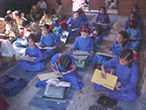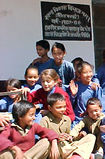
 The
National Policy of Education (NEP), 1986 and its Programme of
Action 1992 accorded an unqualified priority to Universalisation
of Elementary Education. The policy shifts the emphasis from enrollment
as well as retention and achievement. The policy received a further
impetus as a consequence of the declaration of the 1990 Jomite
World conference, which called upon the countries to take effective
steps for achieving 'Education for All' by the year 2000 AD. The
modified version of NEP - POA, 1992 stated "It shall be ensured
that free and compulsory education of satisfactory quality is
provided to all children up to the age of 4 years of age before
enter 2?"
The
National Policy of Education (NEP), 1986 and its Programme of
Action 1992 accorded an unqualified priority to Universalisation
of Elementary Education. The policy shifts the emphasis from enrollment
as well as retention and achievement. The policy received a further
impetus as a consequence of the declaration of the 1990 Jomite
World conference, which called upon the countries to take effective
steps for achieving 'Education for All' by the year 2000 AD. The
modified version of NEP - POA, 1992 stated "It shall be ensured
that free and compulsory education of satisfactory quality is
provided to all children up to the age of 4 years of age before
enter 2?"
As a sequel to the spirit of NEP-OPA, a large number of central
and state-sponsored programmes were launched. Very soon it was
realized that most of these programmes were deficient in delivering
the goods, as they were heavy / supply based and did not provide
contextually. It was also felt that in a vast country like India
any centralized scheme of education would not succeed because
we have to attend to more than a half a million habitants and
equal number of other small tiny regions and hutments.
Having realized the significance of contextually for imparting
education at the primary stages, it was felt that planning process
needs to be based on desegregated targets. To begin with, it was
decided that the districts may be considered as a unit for planning
and management, this 'home grown ' idea actually resulted in the
emergence of the District Primary Education Programme DPEP. Imbibing
the spirit of the constitution and education policy provision,
the district primary education programme emerged in 1994 as a
response to various challenges in the Primary Education sector.

 DPEP
adopts a historic approach and has the essential ingredients required
to universalize access, retention and improves learning achievement
and reduces disparity among social groups. The programme seeks
to ' Universalize' primary education by revitalizing the existing
system. It seeks to identify and tackle ' inefficiencies' by integrating
innovative practices and approaches. Adopting an areas specific
approach, with districts as a unit of planning the key strategies
of the programme have retained the contextually and sensitivity
to local condition and ensuring full participation of the community.
DPEP
adopts a historic approach and has the essential ingredients required
to universalize access, retention and improves learning achievement
and reduces disparity among social groups. The programme seeks
to ' Universalize' primary education by revitalizing the existing
system. It seeks to identify and tackle ' inefficiencies' by integrating
innovative practices and approaches. Adopting an areas specific
approach, with districts as a unit of planning the key strategies
of the programme have retained the contextually and sensitivity
to local condition and ensuring full participation of the community.
There is a marked force on sustainability, equity and local ownership.
The emphasis on participate planning and management and capacity
building are clearly articulated. Acknowledgment of the fact that
the programme would continue to evolve as it progresses, makes
it flexible and dynamic in nature, providing room for experimentation
and accommodating felt need through involvement.
The scope to pilot and either scale up the various approach tried
out has been built into the programme with following objectives:
- Reduce over all primary dropouts rate for all students to
less then 10 percent.
- Raise average achievement levels by at least 25% over measured
base line, ensuring achievement of the basic literacy and numeric
competencies and minimum of 40% achievement level, in other
competencies, by all primary school children.
- To provide access for all children to primary schooling or
equivalent non-formal education.
- It also seeks to strengthen the capacity of National, State
and District level institutions and organization for planning,
management and evaluation of primary education.

